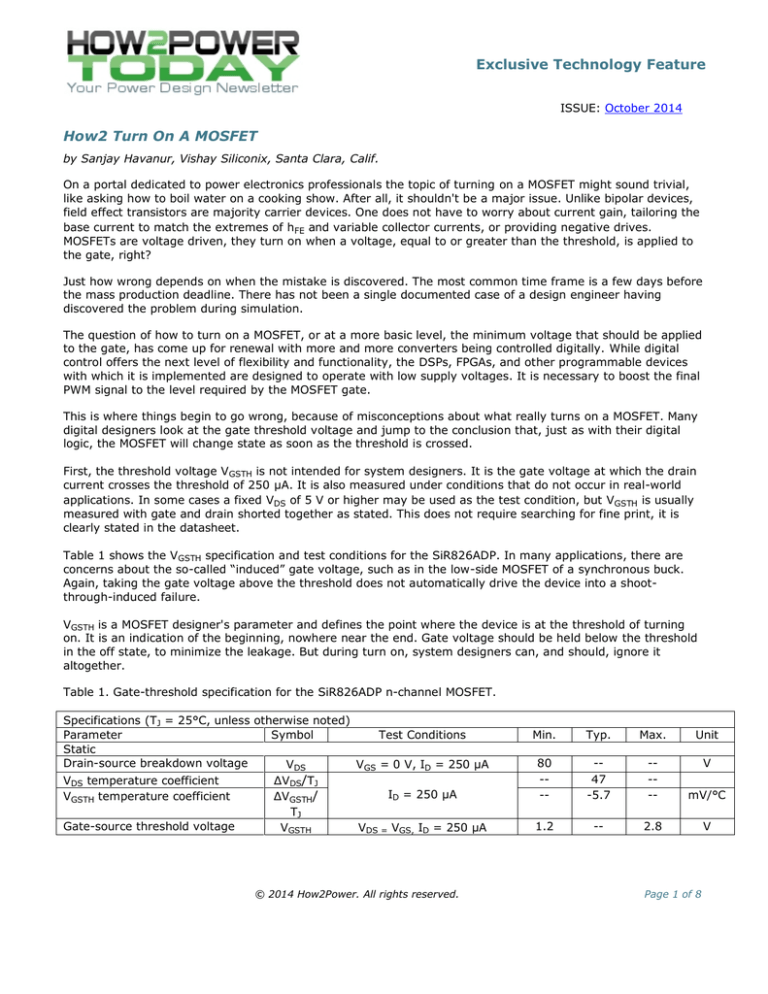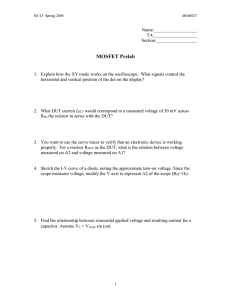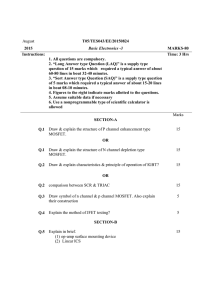
Exclusive Technology Feature
ISSUE: October 2014
How2 Turn On A MOSFET
by Sanjay Havanur, Vishay Siliconix, Santa Clara, Calif.
On a portal dedicated to power electronics professionals the topic of turning on a MOSFET might sound trivial,
like asking how to boil water on a cooking show. After all, it shouldn't be a major issue. Unlike bipolar devices,
field effect transistors are majority carrier devices. One does not have to worry about current gain, tailoring the
base current to match the extremes of hFE and variable collector currents, or providing negative drives.
MOSFETs are voltage driven, they turn on when a voltage, equal to or greater than the threshold, is applied to
the gate, right?
Just how wrong depends on when the mistake is discovered. The most common time frame is a few days before
the mass production deadline. There has not been a single documented case of a design engineer having
discovered the problem during simulation.
The question of how to turn on a MOSFET, or at a more basic level, the minimum voltage that should be applied
to the gate, has come up for renewal with more and more converters being controlled digitally. While digital
control offers the next level of flexibility and functionality, the DSPs, FPGAs, and other programmable devices
with which it is implemented are designed to operate with low supply voltages. It is necessary to boost the final
PWM signal to the level required by the MOSFET gate.
This is where things begin to go wrong, because of misconceptions about what really turns on a MOSFET. Many
digital designers look at the gate threshold voltage and jump to the conclusion that, just as with their digital
logic, the MOSFET will change state as soon as the threshold is crossed.
First, the threshold voltage VGSTH is not intended for system designers. It is the gate voltage at which the drain
current crosses the threshold of 250 µA. It is also measured under conditions that do not occur in real-world
applications. In some cases a fixed VDS of 5 V or higher may be used as the test condition, but VGSTH is usually
measured with gate and drain shorted together as stated. This does not require searching for fine print, it is
clearly stated in the datasheet.
Table 1 shows the VGSTH specification and test conditions for the SiR826ADP. In many applications, there are
concerns about the so-called “induced” gate voltage, such as in the low-side MOSFET of a synchronous buck.
Again, taking the gate voltage above the threshold does not automatically drive the device into a shootthrough-induced failure.
VGSTH is a MOSFET designer's parameter and defines the point where the device is at the threshold of turning
on. It is an indication of the beginning, nowhere near the end. Gate voltage should be held below the threshold
in the off state, to minimize the leakage. But during turn on, system designers can, and should, ignore it
altogether.
Table 1. Gate-threshold specification for the SiR826ADP n-channel MOSFET.
Specifications (TJ = 25°C, unless otherwise noted)
Parameter
Symbol
Test Conditions
Static
Drain-source breakdown voltage
VDS
VGS = 0 V, ID = 250 µA
VDS temperature coefficient
ΔVDS/TJ
ID = 250 µA
VGSTH temperature coefficient
ΔVGSTH/
TJ
Gate-source threshold voltage
VGSTH
VDS = VGS, ID = 250 µA
© 2014 How2Power. All rights reserved.
Min.
Typ.
Max.
Unit
80
---
-47
-5.7
----
V
mV/°C
1.2
--
2.8
V
Page 1 of 8
Exclusive Technology Feature
Another curve given on the datasheet refers to the MOSFET turning on with increasing gate voltage—the
transfer characteristic. This is illustrated for the same device (the SiR826ADP) in Fig. 1. However, transfer
characteristics are more a measure of current variation with respect to temperature and applied gate voltage.
The VDS is maintained at a constant but high value, sometimes as much as 15 V, and not always disclosed in
the datasheet.
In the curve shown in Fig. 1, at a current of 20 A it is not enough to apply 3.2 V to the gate. The combination
would maintain a VDS of 10 V typical and a continuous dissipation of 200 W. The transfer curve is quite
important when the MOSFET is operated in the linear mode, but has little relevance for switching operations.
Fig. 1. Transfer characteristics for the SiR826ADP.
The curve that has data with the MOSFET fully on is called the output characteristic (shown in Fig. 2.)
Fig. 2. Output characteristics for the SiR826ADP.
© 2014 How2Power. All rights reserved.
Page 2 of 8
Exclusive Technology Feature
Here, the MOSFET’s forward drop is measured as a function of current for different values of V GS. Designers
may refer to this curve to ensure that the gate voltage is sufficient. For each gate voltage where R DSON is
guaranteed, there is a range where the VDS drop maintains strict linearity with current, beginning from zero. For
lower gate-voltage values, as the current is increased the curve loses linearity, goes through a knee, and
flattens out.
Fig. 3 shows the detailed output characteristics for gate voltages from 2.5 V to 3.6 V. MOSFET users usually
think of this as the linear mode. However, device designers refer to the grey area as the current-saturation
region—for the given gate voltage, the current that can be delivered has reached its saturation limit. Any
increase in applied VDS will be sustained with only a slight increase in the current, whereas even a slight change
in current can lead to a relatively large increase in VDS.
For higher gate voltages, when the MOSFET has been fully turned on, any operating point will be located in the
area shaded in green to the left, marked as the resistive (or ohmic) region. Note that all curves are typical, with
no minimum or maximum limits, and derived at 25°C. At lower temperatures the gate voltage required to keep
the device in the resistive region will be higher, increasing at the rate of 0.3%/°C.
Fig. 3. Expanded output characteristics for the SiR826ADP.
When confronted with the output characteristics, designers invariably demand to know the RDSON at their
particular operating conditions. Typically it will be at a combination of V GS and IDS where the curve has strayed
from the straight and narrow line into the grey area. For example, in the case above it could be a gate voltage
VGS = 3.1 V and a startup current of 10 A. They understand RDSON will be higher than specified, but can the
MOSFET manufacturer provide an approximate indication?
Since both VDS and IDS are available on the curve, there is a temptation—often succumbed to—to divide the two
and arrive at the “effective” RDSON. Unfortunately there is no RDSON to calculate here. It does not exist under the
given conditions. Any segment of the load line that represents a resistance must pass through the origin in a
linear fashion. One can, of course, model the load line in its entirety as a nonlinear resistance. If nothing else, it
will ensure that any understanding of real-world behavior is maintained at the origin (0,0).
The real clue to turning on the MOSFET is provided by the gate charge curve shown in Fig. 4. While the curve is
routinely offered for every MOSFET, its implications are not always understood by designers. In addition, recent
© 2014 How2Power. All rights reserved.
Page 3 of 8
Exclusive Technology Feature
developments in MOSFET technology, like trench and shielded gates and charge-compensating superjunction
structures, demand a fresh appraisal of this information.
Fig. 4. Gate-charge characteristics.
To start with, the term “gate charge” itself is somewhat misleading. The linearized and segmented curve does
not look like the charging voltage of any capacitor, no matter how nonlinear its value. In reality the gate charge
curve actually represents a superposition of two capacitors that are not in parallel, have different values, and
carry different voltages. In the literature, the effective capacitance as seen from gate terminal is defined as:
CISS = CGS + CGD.
While this is a convenient entity to measure and specify in the datasheet, it is worth noting that C ISS is not a
physical capacitance. It would be a misconception to imagine that the MOSFET is turned on simply by applying a
voltage to “the gate capacitance CISS.”
As shown in Fig. 5, prior to turn-on, the gate-source capacitance CGS is uncharged, but the gate-drain
capacitance CGD has a negative voltage/charge that needs to be removed. Both capacitors are nonlinear, and
their values can vary widely with respect to applied voltage. The switching characteristics, therefore, are
dependent more on their stored charges rather than the capacitance value at any given voltage.
© 2014 How2Power. All rights reserved.
Page 4 of 8
Exclusive Technology Feature
Drain
Up to
rated VDS
+
CGD
CDS
_
Gate
RG
CGS
0V
Source
Fig. 5. Gate capacitances with initial voltages.
Since the two component capacitances that make up CISS are physically different and are charged to different
voltages, the turn-on process also has two stages. The exact sequence is different for inductive and resistive
loads; however, in most practical applications the load is heavily inductive and can be described using the
simple circuit model shown in Fig. 6.
ILOAD
IDS
VGS
+
VIN
Gate
Source
Fig. 6. Simplified inductive turn-on circuit.
© 2014 How2Power. All rights reserved.
Page 5 of 8
Exclusive Technology Feature
In reference to the timing diagram in Fig. 7, the sequence of events during turn-on is as follows.
T0 to T1: CGS is charged from zero to VGSTH. There is no change in VDS or IDS.
T1 to T2: Current begins to rise in the device as the gate voltage rises from V GSTH to the plateau voltage VGP.
IDS rises from 0 A to the full load current, but there is no change in V DS. The charge associated with interval T0T1 is the integral of CGS from 0 V to VGP and specified in the datasheets as QGS.
T2 to T3: The flat region between T2 and T3 is also known as the Miller plateau. Prior to turn-on, CGD is
charged to supply voltage VIN and holds it until IDS has peaked to ILOAD at T2. Between T2 and T3, the negative
charge of (V IN – VGP) is converted to the positive charge corresponding to the plateau voltage VGP. This is also
seen as the fall of the drain voltage from VIN to near zero. The charge associated is approximately the integral
of CGD from zero to VIN and specified in the datasheets as QGD.
T3 to T4: As the gate voltage rises from VGP to VGS, there is very little change in VDS or IDS. However, the
effective RDSON reduces marginally with rising gate voltage. At some voltage above VGP, the manufacturers feel
confident enough to guarantee an upper limit on the effective R DSON.
ILOAD
VIN
VGS
Projected
VDS Fall
VGP
VGSTH
T0
Actual
VDS Fall
(For HV)
T1
T2
T3
QSW
QGS
QGD
T4
Turn ON
Sequence
QG
Fig. 7. Gate-charge components and timings.
When the load is inductive, the rise of the current in the MOSFET channel must be completed before the voltage
begins to fall. At the beginning of the plateau, the device is OFF with simultaneous high current and voltage
across drain and source. Between T2 and T3, a charge of QGD is delivered to the gate, and at the end of it the
MOSFET characteristic has changed from constant current to constant resistance mode. During this entire
transition there is no significant change in the gate voltage VGP, which is why it is not meaningful to associate
the turning on of a MOSFET with any specific gate voltage.
Similar analysis can be made for turn off, where the same two charges must be removed from the gate in
reverse order. While the sum of QGS + QGD guarantees that the MOSFET will be fully on, it does not guarantee
how fast. The rate of change in voltage or current is determined by the rate at which the gate charge
© 2014 How2Power. All rights reserved.
Page 6 of 8
Exclusive Technology Feature
components are applied or removed, which is nothing but the gate-drive current. While fast rise and fall times
are necessary to reduce switching losses, they also introduce system-level problems of high peak voltages,
ringing, and EMI, especially during inductive turn off.
The simplified linear voltage fall shown in Fig. 7 assumes a constant value of CGD, which is rarely true for real
MOSFETs. In particular, the CGD of a high-voltage superjunction MOSFET shows extremely nonlinear behavior,
as illustrated in Fig. 8 for the SiHF35N60E. There is more than a 200:1 variation in the CRSS value within the
first 100 V. As a result, the actual fall time of voltage against the gate-charge curve may look more like the red
dashed line in Fig. 7.
Fig. 8. Capacitance variations with respect to applied VDS.
The rise and fall times, and their corresponding dV/dt values, depend more on the CRSS values at higher
voltages than the integral of the entire curve specified as Q GD. While comparing devices across different design
platforms, users need to be aware that a MOSFET with half the Q GD will not necessarily switch twice as fast or
have half the switching losses. Depending on the shape of the C GD curve and its value at higher voltages, it is
quite possible to have a device that has low QGD in the datasheet but shows no increase in switching speed.
Conclusions
In the real world, turning on a MOSFET is not an event but a process. Designers have to stop thinking of
applying a VGSTH, or some other voltage, as an input at the gate that will toggle the output from high to low
RDSON. Questions concerning the RDSON at a gate voltage below some specific value are not valid, because it is
not the gate voltage per se that turns on a MOSFET. It is the two charges QGS and QGD, injected into the device
through the gate pin, that do the job.
The gate voltage will rise above VGSTH and VGP in the process, but that is secondary. The speed with which a
modern power MOSFET turns on or off is also not a simple function of QGS or QGD. A detailed study of both the
gate-charge curve and capacitance characteristics is necessary to compare switching speeds, especially for
superjunction MOSFETs.
© 2014 How2Power. All rights reserved.
Page 7 of 8
Exclusive Technology Feature
About The Author
Sanjay Havanur is currently the senior manager for system applications at Vishay
Siliconix. Previously, he served as the principal applications engineer at Alpha & Omega
Semiconductor. Since receiving his Master's Degree in Power Electronics and Drives at
the Indian Institute of Technology, Mumbai in 1983, Havanur has gained extensive
experience in the field of power electronics, having worked in design and applications
in both India and the U.S.
He has published papers and application notes in technical journals, and holds several
patents relating to high-frequency power conversion. Sanjay Havanur's current
interests include novel and efficient power conversion topologies, energy harvesting
techniques and solar power.
For further reading on MOSFET characteristics and operation, see the How2Power Design Guide, select the
Advanced Search option, go to Search by Design Guide Category and select “Power Transistors” in the
Component category.
© 2014 How2Power. All rights reserved.
Page 8 of 8






